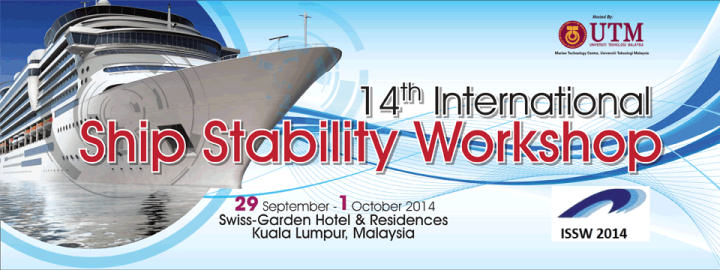 in Russian
in Russian in Russian
in Russian
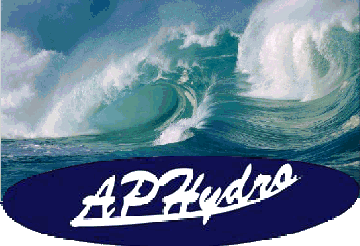
Keywords: Hull structure, stormy seakeeping, noncontradictory design of ship, ship design, heavy sea navigation, noncontradictory decision, seamanship and shipbuilding consequence optimization
The target noncontradictory design of the ship, as a complex and unified engineering structure reaches optimality criteria for technical and navigational efficiency only when a comprehensive regional perspective for marine navigation and operations in specific geographical and meteorological conditions. So, in the northwestern Pacific, Far East Russia, it is impossible to use a fleet calm weather, even for coastal navigation, and which is widely represented in foreign offshore temperate latitudes. Conceptual ship design provisions consistent with findings of the mechanics of harmonious dialogue with the ship in stormy sea navigation specific conditions, good seamanship bound axiom technical aesthetics of the absence of which it would be superfluous on a beautiful ship.
Far away ocean campaigns between regions of fisheries and open the Sakhalin-Kuril port point abound storm winds, with moving ice floes and heavy icing decked devices and superstructures the cold seasons. All classes of fishing and auxiliary fleets should be designed to reflect the actual absence of reliable harbors on Sakhalin and the Kuril Islands, which requires crews constant readiness to leave the port harbors for the inevitable meeting of all storms and hurricanes in the open sea in deep water away from the shore.
Contrary of a large sealiners, for designing fishing, rescue and survey vessels, the most important requirements are all-weather effectiveness and safety at work of the deck crew, possible routine use of all ship arrangements and mechanisms in conditions of storms and icing. Purpose of this fleet is fully determined by the initial design decisions to achieve the best storm seaworthiness of vessels, strictly coordinated with experienced sailors on the bridge watch; on the upper decks and fishing, in the ship's machine and industrial environments. Navigation conditions in the Far East of Russia should be evaluated winds exceeding 30 m/s; large progressive wave front height of 10 meters and the slope of the order of 30°, with periods of 6-8 s on the Sea of Okhotsk and on the Sea of Japan, and to 15 s in the Pacific Ocean; and regularly the standing ninth waves of dangerous cross with steep ridge more than 45°.
Optimization techniques based on private engineering solutions in the absence of "sufficient conditions" to determine the only true conclusion of the project. Freedom and necessity of a creative choice associated with fundamental contradictions and insufficiency of initial requirements to promising vessel is permitted solely in good seamanship and literacy mariners in formulating design requirements and evaluation of technical solutions for special cases of the new marine equipment.
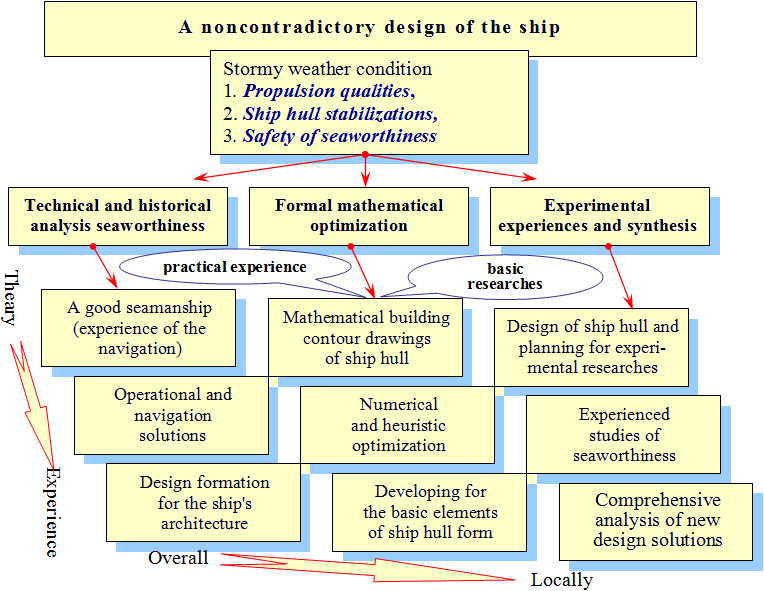
Noncontradictory designs for an effective seagoing vessels is possible with the aid connected in reverse stages exploratory research targeted at consistent harmonization of requirements for the ship as a unified engineering structures [1]. Target design with verification of selected engineering solutions may be submitted counterclaims passes (steps), as the analysis of "top-down" - from the total project prerequisites for private technical solutions; and synthesis of "bottom-up" - from the technological capabilities available to the optimal intended project of the new ship as a whole.
Noncontradictory design optimization reduces to harmonize operational requirements for promising ship running on a pass by logical synthesis stages of the project: top-down (Fig. 1-a), then the reverse sequence verification analysis of decisions on the way: bottom up (Fig. 1-b). New technical solutions accompanied concept exploratory synthesis top down, where based on the wishes of seafarers occurs coordination technological capabilities of modern shipbuilding and projected long-term seaworthiness of the ship. Private layout analysis and sturdy engineering decisions on the design phase, bottom up completes perfecting instruction to Mariners, with a detailed experimental study of all modes of navigation and seagoing documenting special properties and proven recommendations for optimal resolution of dangerous situations at sea, with instructions on Regulatory crew actions under difficult, ice and stormy weather offshore activities, including given features and benefits of the project implemented innovations.
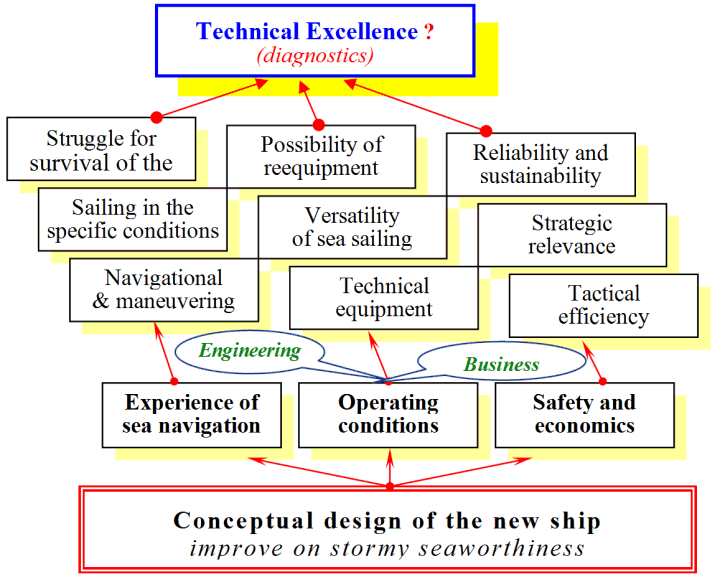
Depending on the destination and the conditions of navigation a highly specialized ships and vessels shall obtain quite definite and formal features of the projected ship's architecture and arrangement of ship equipment and compartments. Such arrangements are general architectural principles of constructing ships needed for the initial design study of generalized conclusions on the key stages of the search for engineering solutions in dialogue with experienced navigators - actually responsible for the efficient and safe operation of the projects produced new vessels. Are formally independent (orthogonal) directions of research design based on a limited amount technical decisions on hull form and architecture of ship:
1. Depending on the nature of the shiploads, cumbersome superstructures and onboard equipment, appearance and general architecture features of a marine vessel, may be submitted in the following ship design ways:
semi-submersible vessel if operational requirements do not necessary provides any deck operations on the high seas, especially in the fresh weather or stormy conditions;
decks vessel if provides for marine works, fishing and fish processing, rescue operations and other works on the upper decks or water permeable (ventilated) below deck in all weather conditions;
high towers of vessel superstructures especially if destination provides large amounts of indoor comfortable accommodation for passengers, for motor mobile or amphibious vehicles, aviation equipment decked, unwieldy antenna complexes, etc.
2. Operational opportunities of the seagoing vessel completely determined by the requirements on necessity to maintain an all-weather navigation and effective management of marine operations in complex navigation, storm and ice conditions in the specified geographical regions:
ships for unlimited stormy navigation with the possibility of all-weather marine works the highest requires of design optimization based on narrowcasting specialization seagoing vessel, that formally only increases the cost of its design and shipbuilding.
an unlimited sailing vessel without all-weather for marine works possibilities it is only capable of storming conditionally safe in severe weather conditions under continuous supervision by experienced navigators, which have negatively expensive affects to sailing costs, and the deterioration of ship machineries, which undergoing excessive strain of under heavy conditions of stormy maneuvering;
a limited seagoing vessels which must provides by power machines for evacuation of stormy cyclones and appropriate timely opportunity to thrashing in the ports of refuge, by according to operative onboard weather forecasts, or by commands from shore-based marine services of environment controls of the adjoining coastal water areas.
3. Ship contours quite often determined by stringent economic requirements on the block coefficient for fullness of the hull form, or on depth of water maritime communications and moorings in seaport appointment:
a largest fullness of vessels hull form as the optimum for the highest weight of transported shiploads, at a minimal cost to build and operate seagoing vessel navigation in specified circumstances;
a limited ship draught could be a strict condition, that limits both the general seaworthiness of the vessel, and the possibility of use in complex and heavy stormy conditions;
a speedy (fast seagoing) vessel for a displacement hull form operating conditions are optimized for low power conditions of influence on the hull of the vessel by the storm waves, which is certainly a positive effect on the propulsion and stabilization of the vessel in motion in calm water.
It is important to note that the present research in the field of stormy seaworthiness are most relevant for vessels with a medium displacement, for which the length and height of storm waves comparable with the main dimensions of a marine vessel. As an analytical tools is activated synthesis of good seamanship technical experience and new engineering justification to build outside appearance (ship's architecture) and the main elements of the hull shape, which directly affect the seaworthiness of the ship maneuvering and conditions in difficult, storm and ice conditions for the navigation.
Unlike the midlatitude navigation of warm seas, the Russian Far East requires highly specialized vessels for special stormy and ice sailing conditions, operational efficiency which is determined by minimizing the lead time to loss of storming active (waiting for good weather by the sea). Actual absence ports of refuge also serves as the initial condition to achieve unlimited storm seaworthiness as necessary design background to ensure continuous and all-weather conducting fishing, rescue or exploratory operations on the high seas.
Effectiveness of all-weather for marine works is due: habitat crew comfort smoothness and small stormy pitching or rolling; Protected deck crew from squalls and chilling northern winds; The possibility of heating compartments for stable operation of marine services and decked teams in the winter fisheries or hydrographic expeditions. Then the functional goals of design optimization proceed from navigation requirements for propulsion arbitrary courses relative to of storm excitement and winds caused by the optimal distribution of mass and volume of ship compartments, with convenient access to the operating deck; linking different ship deck operations and efficiency of marine processes and comfort of everyday living conditions for the crew.
Conceptual design prerequisites for classes thereunder ships and vessels [1], according to conditions of operation, are reduced to the necessity of achieving generalized conditional seaworthiness:
patrol, rescue and fishing vessels provided propulsion any courses relatively of storm excitement and winds; for mandatory stabilization pitching or rolling to maintain deck operations in all weather conditions;
rescue vessels and patrol must have a minimum of rolling and be stable to storm course; and at the same time be able to actively maneuver in difficult weather conditions and difficult navigation;
all three classes of vessels must have a minimum pitching and provide non sweep the stern working deck on the move forward under the main (marching) engines, possibly due to excessive wave sweeping, heave and yaw in the bow of the ship hull;
unconditional safety of emergency on storming sea without motion is not put essential condition, because in emergency situations qualified crew can take active steps to install storm sails and floating anchors.
In practice, this design tasks related aerohydromechanic the ship in heavy wind and storm waves, with the target to achieve functional: 1 propulsion; 2 stabilization of the ship hull; 3 ability to conduct deck operations in all weather conditions. Conclusion of the project limited to the following features and ship's hull form and superstructures architecture:
1. Reduction of the area, the transverse and longitudinal moments of inertia waterplane and sharpen it bow and stern to reduce the power impact of storm waves and saving propulsion with low pitching.
2. A significant decrease the volume of ship's hull of surface bow and stern, and tumblehome of sterns and boards in the middle of the hull at waterplane, which stabilizes the progress in cutting mode of storm waves.
3. Exclusion and the general flare of boards of continuous upper deck that will prevent excessive pitching waves with punches on the sides and decks, to create opportunities for active management course in stormy conditions, and takes the edge off the problem deicing.
These rules are not contrary to the natural shape of the hull constructions in general engineering optimization and navigation requirements for prospective ship seaworthy increased:
propulsive quality on calm water due to sharp waterlines bulbous bow and rounded contours of frames in the middle of the hull, enclosing the largest volume in minimal surface ship plating;
exclusion of boundary layer separation near the rudder and propulsion is achieved by cruiser stern with smoothing rib lines on a theoretical line drawing, contributing to small gradients and low vorticity near area of the propulsion;
passableness in the ice at the autonomous navigation can be improved in the cutting regime and break under ice fields below, which partly solves the problem of ice protection propulsion.
Fishing waters are often characterized smaller depths of marine and offshore shallow water where storm danger are compounded by long sea level oscillations, killer waves and extreme currents, resulting from the transformation of storm waves and swell with their active interference, increase the dispersion wavelengths, against density stratification of water near the mouths of rivers and in areas of bottom waters rise. Such adverse hydrodynamic processes observed in the narrows, at anchorages on raids and on the approaches to the gate of the seaports where danger to mariners grow even at moderate winds and long-wave responses to remote coasts storm.
Undecidable difficulties arise in finding design solutions with the aim of harmonizing the safe sailing hydrodynamic regimes in stormy ways on a shallow water. Then, each project for promising and existing vessels must be undergo sea trials with complex remote-controlled towing models at the surf zone in shallow water, for example, and then submitted at teachings of navigators, and in the algorithms for automatic control of a vessel is fast deep water.
Vessels enhanced storm seaworthiness, capable of maneuvering arbitrary storm passages and courses at nominal (or minimum) available power, as a result, are exempted from the excessive costs for fuel and maintenance of the main engines, which is more than cover one-time expenses of the target design, sturdy construction and sea trials of ships for work in the northern latitudes of the Far Eastern seas.
Conditions of industrial activity of the fishing vessel is not fishery abound with originality schemes and methods of deployment fishing gears, from which also should not be following variety of technical solutions in the construction and arrangement of ship's contours architecture. The criterion of designing of perspective vessel can be establish that fishing trip seaworthy qualities should be in full operation crew at the conditions of storms and icy winds of the northern seas:
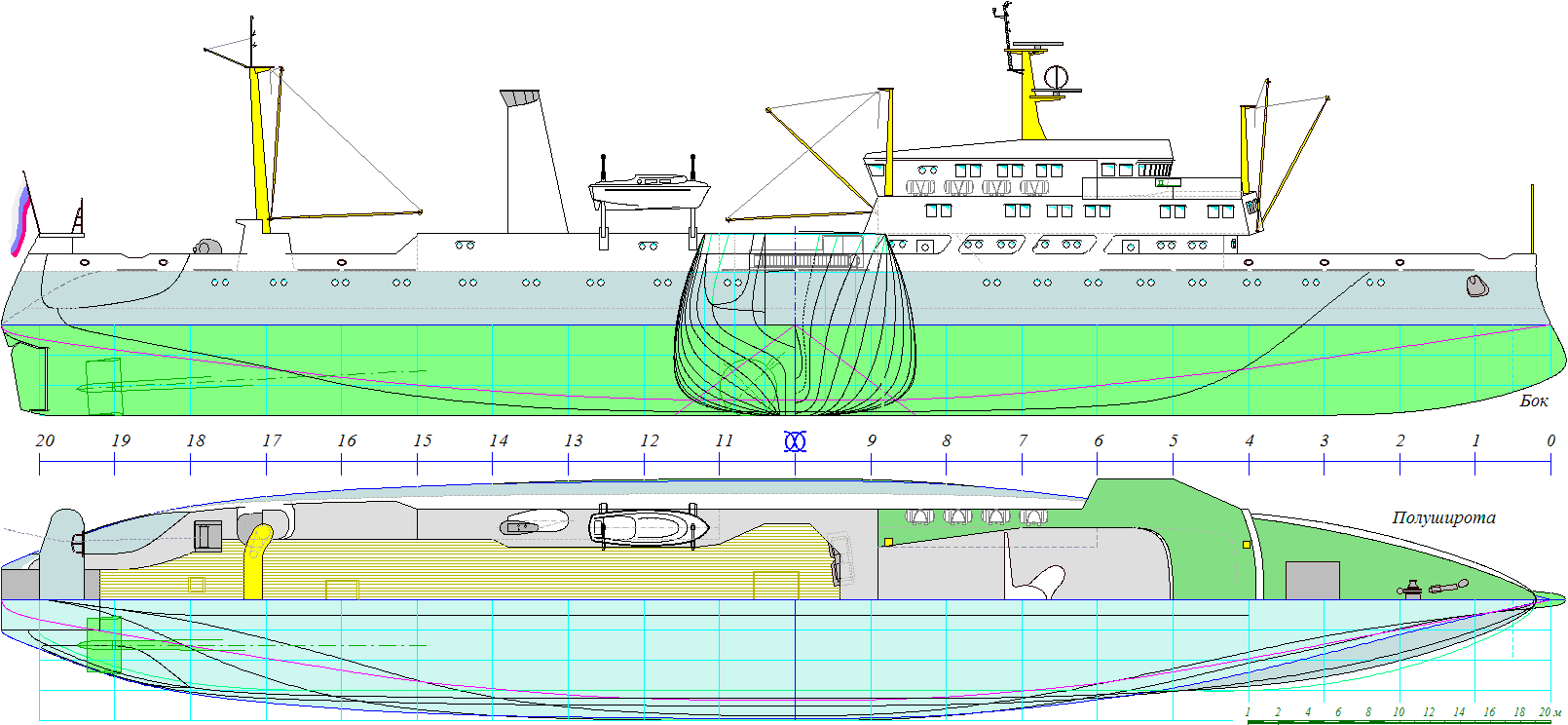
1. Habitability quality, whose adequate for action with fishing gear on the upper deck, and for continuous shipboard operations and production processes for fish industry:
free movement of arbitrary courses with the trawl, in the fishfinding regime and by transitions between the fishing areas;
possibilities for active maneuvering with trawl team on the upper deck, during work when setting/pulling of fishing trawl net.
2. Modes of moving or drift fishing gear when folded and stopped fishery and manufacturing operations:
mooring operations in the open sea for receiving and transfer ready stocks of fish products;
emergency modes of navigation and storming awaiting calm weather.
Mighty prototype promising trawler with enhanced seaworthiness can be traditional Superatlantik [2] that is configured at a similar case in displacement of the historic ship the XIX century (Fig. 2). Superatlantik able for 24 days to produce the fishery and take on board some 1.200 tons of fish products.
Fishing fleet usually does not have the technical capacity to safely holding fishing operations in a stormy sea. In the shipbuilding industry, this means that as at the dawn the Great Geographical Discoveries, in the design of promising types of ships should be used Navigational experience and knowledge of good seamanship, which is especially important to actually achieve all-weather efficiency of fishing operations. Participation reputable captains mentors capable of perceiving engineering innovation with many years of experience of command positions of fishing vessels in the far fishing voyages, it is extremely important in the search for optimal design solutions, initially need to be agreed with the practical development and effective use of the latest models of marine equipment.
To improve storm seaworthiness, useful historically experience embodiment cruiser stern aft, not perceiving impacts of large ridges of storm waves. Compensation will be improved hydrodynamic loads assuming of unimpeded flooding forecastle deck that will become a special freeboard dampers pitching, and contribute to improving the conditions of marine operations and safety of seafarers on the open aft a deck fishing:
1. In the stern is arranged two level decks above the main watertight deck of fishing vessel hull:
shelter deck of the fish processing plant, which is discharged through semi-portico flows used in the production of sea water;
upper deck provides simultaneous operation of two fisheries trawls (doubles) at their rising / setting; fully shelter from wind effects and tumblehome inward to reduce the rolling under the blows of the wave crests and squall winds.
2. Narrowed (cruiser) stern deck do restrict access to the danger zone under the trawl bridge and load portal, makes it possible to full mechanization for a heavy operations with trawl boards in the side cut-sections under cargo hooks between stern transom and portal bridge, with marching mounting boards in these cut-sections board in close proximity to dragrope winches.
3. Ship contours provide stabilization stern of the hull on the move forward, and when trawl towing, settings / arising fishing gears in heavy storming. Stern part of ship hull made heavier by building the stern draught, and the completeness of bow contours reduced to avoid capture body wave crests, which frees yaw and promotes the smooth flow of flooding forecastle deck of the wave crests. Stormy stabilization stern deck also shown intensive outboard dynamics of the wave ridges, which board cut-sections partly compensate the rolling.
On the navigating bridge is provided wide overview of trawl, deck, which is important for safety monitoring team trawl, then vessel is maneuvering in the storm. Continuous upper deck allows the master to deploy trawl fishing gear on the entire length of the trawler at their repair or modernization; Simplifies migration of ship's stores or goods between the forward and the middle holds the high seas; and promotes compensation rolling with a side tie-storm waves on the upper deck.
Believing as a prototype average freezer trawler-seiner type "Eaglet" (Project 333 Atlantic): L - 62,25 m; B - 13,8 m; T - 5,2 m; W - 2400 m3 (2467 m); load capacity of 230 tons; crew of 40 seamans. Ships hull lines constructed by analogy with a picture of the ship Marco Polo from the XIII century (Fig. 3), which would mean using all the key technical solutions to optimize the hull form and the ship's architecture to achieve the best medium-tonnage fishing vessel with a best stormy seaworthiness.
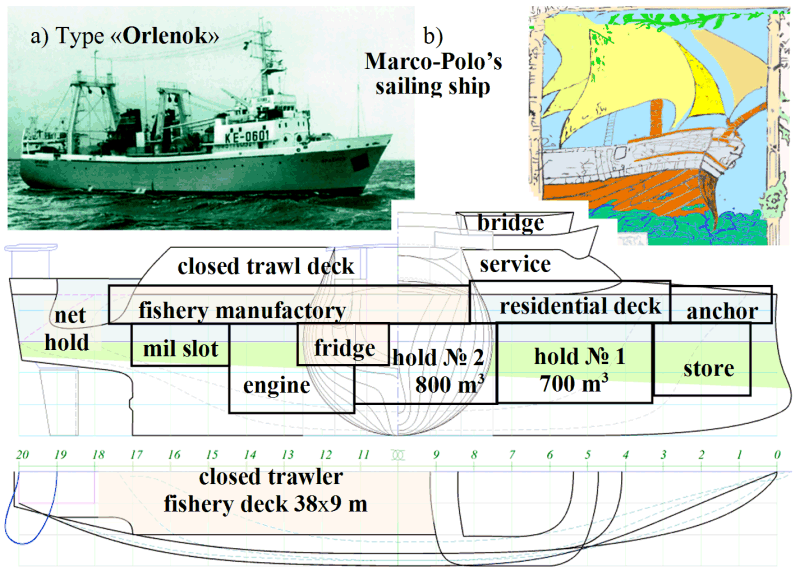
Anchor-mooring device placed indoors forepeak (fig. 3), shelter from winds and spray ice fishing deck, which is important for the effective operation of the crew in the winter cold seas of Russia. Minimum area forecastle deck is arranged for open access to the hold manhole number 1, which is necessary for unloading of frozen fish products in the open sea at calm weather or in the shelter of high boards transport refrigerator.
In the contours of the trawler used technical solution for hydrodynamic compensation pitching when the vessel is relatively arbitrary course of storm waves a trochoidal nature [4]. In the process of superposition and proportional counter storm ship waves force effect is concentrated in the area of bilge contours contours, where the trim points degenerate into translational force vertical ascent / dive of ship hull. A prerequisite of this process is to maintain plane floating and lack of running trim in calm water, even during the test model at supercritical high speed full ahead. In sea trials (Fig. 4) is confirmed as steady state course by teething with ridges of storm waves, which practically does not change trawler form dissecting wavefronts, which is the condition of conservation of propulsion and smooth pitching on a large storm waves.
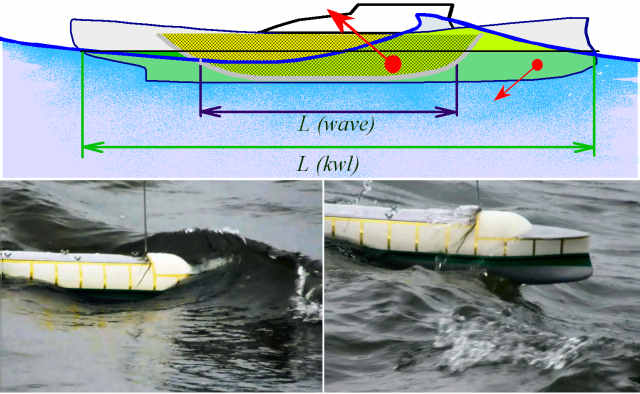
In sea trials also raised the issue of reducing the potentially dangerous effects of heaving, which course at high speeds (Fig. 4) is accompanied by a wave flouding bow deck and almost complete ascent of ship hull between wave ridges[1]. For a predictable reaction to control actions trawler steering stabilizers and requires precise knowledge of at least the characteristics of stability at of ship hull at any time. Using rounded frames allows you to save the value of metacentric height [5] at different planting the conditions at then vessel is heave that can be used in the laws of the automatic steering-ahead to sending commands to rolling stabilizers to prevent uncontrolled roll by turning dangerous for trawl, fishing operations team at on the upper deck in heavy weather. If the active wing stabilizers installed in the flow propellers [6], their effectiveness will be maintained during fishing operations with trawl or other outboard gear.
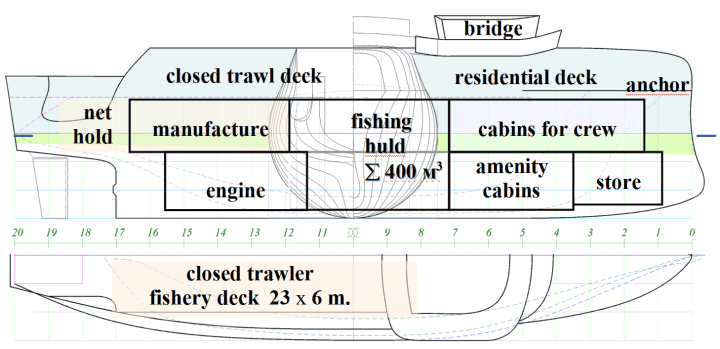
Overstated to 7.5 m draught trawler ensures its stable motion in a stormy sea with the largest proportionate ridges of wind waves and swell. Due to this displacement precipitation increases by more than 1,000 tons, which corresponds to the rank of a large trawler with initial average dimensions. Increasing the volume of ship's stores and cargo holds is required for autonomous operation fishery then vessel is in remote areas of the Pacific Ocean, not ensure a sustainable port of refuge, which is an important operational requirement for promising project trawler.
Traditional fishing vessels for the Russian Far East are seiners trawlers with a displacement about 800 m3. Possible to build a similar medium variant trawler providing shelter deck crew in storm conditions winter seasons northwestern Pacific. As the prototype uses modern trawler STR-420 type "Nadezhny(Reliable)»: L - 44,9 m; B - 9,5 m; T - 3,8 m; W - 806 m3 (781 t); hold 200 m3 (100 t), cooled to -7°C; crew - 22 mariners.
In modern conditions in the Far East of Russia is difficult organized fishing expedition with the support of large fish processing bases. Extra in comparison with the prototype of a new displacement trawler used to increase the capacity of freezing equipment, of the fish processing plant unit, as well as to increase the volume and the number of freezing hold of ship's stores to operate autonomously away from the fishing ports.
Contours of the hull similar to the previous project trawler (Fig. 3). The main difference is the absence of layer of shelter deck (Fig. 5), which makes the fishing trawl deck by main deck watertight hull of fishing vesssel. Deck of fishing plant accommodation and amenity rooms falls below the waterline. To ensure emergency flooding living deck included in sealed circuit freeboard reserve buoyancy. Forecastle deck with anchor-mooring devices locked superstructure, with output the mooring roller through at shelter from the wind and waves semi-porticus that is necessary for the prevention of icing, preservation of stability and minimize rolling in heavy storm wave flouding on the bow of ship hull.
Rounded frames serve to preserve the stability of the same draught in different of ship hull conditions on vertical heaving [5], which is important for stabilizing by control of ship hull in storm conditions to the predicted pitching control and safety deck works and fishery operations at different loadings of the trawler. Narrow cruiser stern minimizes external loads on the move on a wave or rising of trawl gear. To work with trawl boards in the stern sections of the shell are arranged cut-sections. Trawl slip has overlapping scheme for the restructuring of fishing nets to work with.
Deep hold allows you to choose stacking height of made of fish products, thereby adjusting the initial hydrostatic stability change in depending on the current amount of fuel and ship stocks of the trawler.
Seaworthiness of fishing vessel underlie its effectiveness on high seas fisheries. Yet to achieve the desired course mode navigator has some freedom in choosing the course and on the main thrust engines (usually on a wave), which also allows a significant diversity in the contours of the ship's construction and the principles of the architecture of the fishing vessel. Consider the case of the rescue ship, the project brief for which specifies the possibility of confident maneuvering and stable motion with respect to an arbitrary course by stormy waves.
Small ocean-going vessels of the auxiliary fleet used for various purposes, including the extremely difficult conditions of navigation. It can be life-saving operations, emergency towing vessels in stormy conditions, special delivery mail and small packages into cruises, as well as conducting search operations and marine researches at complex, and the ice storm sailing conditions.
Medium ship may have rugged hull enough for the active maneuvering in heavy waves and under the blows of hurricane winds. Active stabilization of pitching, as well as a dynamic influence on the draught, roll and trim of the vessel with the use flapping wing stabilizers and automatically controlled rudders and propellers are possible in principle, provided that the form of the hull and superstructure architecture provide passive reduction in the intensity of force interaction of ship hull with marine waves and wind (fig. 6).
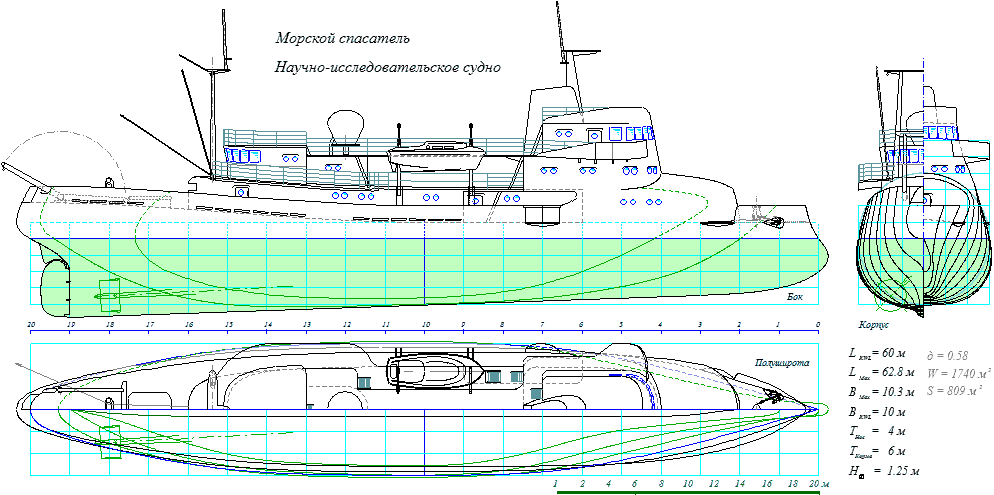
Believing that the rescue fleet is formed exclusively from professional sailors, will not impose specific requirements for habitability and comfort for the crew, placing major demands only the unconditional fulfillment of marine tasks in any weather conditions. Using as a prototype historical Arab ships from the Age of Discovery, define hull shape and layout of these devices ship design and technical features:
1) ship hull as a whole is similar a circular cylinder, which minimizes the rolling in rescue operations in a stormy sea;
2) main volume of ship hull and the center of buoyancy shifted to stern part, that shifts to stern the center of pitching and yawing, approaching them to the area of the rudder and propeller;
3) narrowed and sharpened bow waterline not provide a wave of floating and heawing, making surfacing and center axis of pitching while the vessel shifted to the stern, closer to the middle of the hull;
4) full stern with high castle and deeply immersed fin sternpost for best levels of manageability in storm conditions, it is allowing for crew to work operations on flush deck at the stern;
5) main displacement of the ship is concentrated in the middle of the of ship hull, which reduces the transverse moment of inertia of the vessel and allows the use of horizontal rotary movable control shroud [2] on the propellers to calm pitching and trim alignment when positioning in stormy waves;
6) form a surface volume bow of the hull adapted to the cutting of ridges of storm waves under conditions of high wave flouding, which reduced the maximum forecastle deck, superstructure and bow included in the circuit durable waterproof of ship hull.
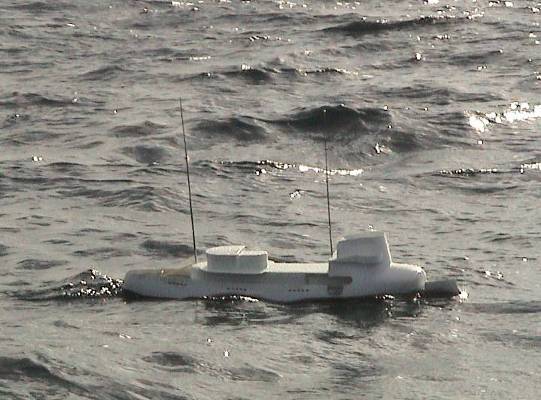 Fig. 7. Rounded ship hull and lower deck of the vessel reduces the intensity of all types of storm rolling on deep water |
Round-shaped ship stability diagram form without the angle of sunset and off-center area and off-center area (the maximum righting moment) beyond 90°. On real roll angles arises large righting moments, respectively, and there is no dangerous rolling moments when the sea surface wave slopes that allows to stabilize the rocking ship with active stabilizers (eg, horizontal movable control shroud allow to control both the roll and trim of the vessel at the same time).
Practically, this means that the concept of non-contradictory following storm nature is the universal rule of designing ships and vessels (Fig. 7), provided as passive as a safe sailing and active technical facilities to achieve the complexity marine tasks.
Itself does not need a rescue ship in maintaining particularly high speed ahead; in operating costs provided for nominal consumption for maximum autonomy and cruising range; and on board ship there is only equipment specifically designed for regular use in accordance with the scheduled services jobs or planned expeditionary requirements.
Shall consider a variant a high-speed ship at the destination which are not optimized design and technical solutions to meet the operational requirements of economically feasible, and are on board complex weapons systems, dangerous both for the ship and for all others.
Patrol and hydrographic ship is designed for continuous duty weatherproof waters of Sakhalin and the Kuril Islands North Pacific ocean, with healthy shipboard weapons and existing complexes constantly monitoring the situation on the open ocean and offshore, ready for fast transitions in heavy and stormy navigation (fig. 8). Besides the protection of maritime borders, the ship is given the responsibility to ensure safety of navigation and saving life at sea, active monitoring and early warning Sakhalin and Kurily offshore services for early prediction of potentially dangerous marine phenomena. [7] [2].
A noncontradictory design of the ship means comprehensive research of modern technical solutions, operating experience and good seamanship of a ship maneuvering in difficult sailing conditions, as well as develop of all aspects of navigation in complex, ice and storm sailing conditions.
As the main requirements for a high-speed ship hull form identifies the need to maintain effective go ahead arbitrary course relatively intense sea wave, provided the maximum stabilizing of ship hull as a platform for all types of weapons and control systems environment of the sea.
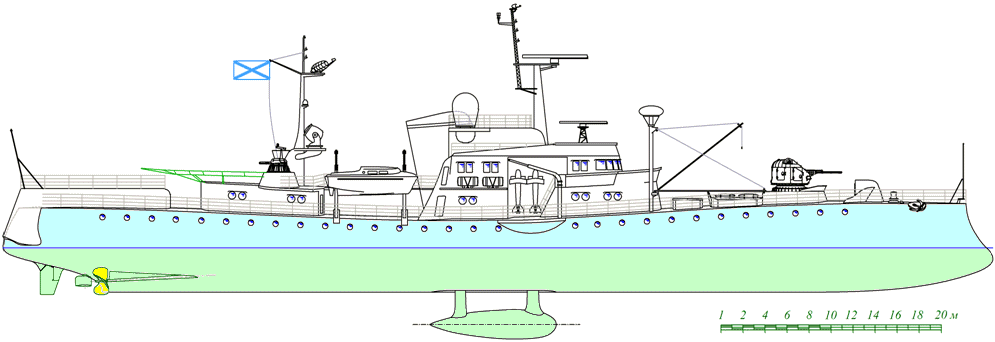
To achieve good seaworthiness into the contours and external architecture of the ship made the following design features:
1) surface sealed enclosure of ship hull is less than the displacement of ship;
2) tumblehome board into middle of the hull side of the ship has a maximum angle at waterline level;
3) the initial metacentric height has a minimum value in a constructive draught and increases as when afloat, and when immersed of ship hull [5];
4) static stability diagram has an S-shape with an angle of sunset 180°;
5) inseparable space of the upper deck minimized by longitudinal arrangement of superstructures and foundations for a decked devices and mechanisms;
6) in stormy conditions on any section of the deck along the board of the ship is filled with approximately the same amount of water, indicating damping of pitching;
7) surface part of the stem of the ship tilted to the stern, and in the underwater part the stem is made inclined undercut the need to avoid yaw and onboard slamming on the move by storm excitement;
8) has a cruiser stern tumblehome and minimum freeboard stern afterrake overhang allowed by the scheme using two-shaft propeller-rudder system;
9) restricted area fin of sternpost lets slide (yaw) with a passing wave, avoiding hard blows of waves in the area of stem bowl;
10) directly behind the propellers mounted horizontal wings of active stabilizers on spring loaded baller [6], which in the case of stopping of the main machines begin to work as emergency storm propulsion;
11) the geometry of the ship's hull with deckhouse determined covering a circular cylinder, and the underwater part of the of ship hull is smooth and does not contain or bilge contours longitudinal keels of bottom and along the sides of the upper deck is arranged an open passage, in which water flows from ridges of storm waves kept using for a decked logging and longitudinal coamings;
12) all household and office space ship located under the upper deck, which is also by main deck watertight hull of the ship.
Only after successful minimization of force action by storm waves on the hull, the ship can be used active dampers for rolling and pitching. Installing the wing stabilizers into the zone of active water flow action after propellers needed for predictable working out commands to stabilize the ship hull [6]. In the case of stopping of the main machines such stabilizers will automatically be started into emergency mode by the storm propulsion, thrust which can be used to hold the ship in a safe storm course.
Operational efficiency is determined by the vessel's ability to perform tasks in a specific geographic region stormy conditions and ice navigation, which should be planned and practiced in detail to be included in guidance Mariners at the design stage of new ships.
Manual navigators always localized geographical features and area of navigation, and are traditionally are the responsibility of acting captains mentors, with years of accident free sailing qualifications in specific marine waters and which are available administrative and technical resources for expert and practical (towing) develop specific action skippers in emergency and emergency situations at sea. Of course, acting captain surveys seaworthy vessels are invaluable very useful when negotiating design solutions for advanced ships, the only reasonable from the standpoint of good seamanship, defining problems of safety of navigation as the objective function to achieve the highest production efficiency of the vessel as a specialized marine engineering structures.
In the new design and technological research is represented extremely useful, navigation experience of active stormy maneuvering, including coordinated with the knowledge of good seamanship deck operations in complex, storm and ice conditions, with subsequent reverification of new developments in severe restrictions noncontradictory design concept of all-weather ocean vessel.
Patents and video tests published in the ship's portal: Shipdesign.ru.
The author expresses his sincere gratitude to really authors of this actual maritime researches: the naval officers - the teachers Kaliningrad Marine College of Fisheries A. A. Kamyshev, G. S. Malenko, E. V. Mironov, D. Ya. Bronstein, and their careful attitude to the maritime and naval engineering history, which found as the basis for creating new ships projects for enhanced seaworthiness, and passed the first experimental verification with their participation into the 1975-1979 years. The main series of analytical and experimental researches performed in 1986 under the guidance of A. N. Kholodilin professor of ship theory Leningrad Shipbuilding Institute. In creating these ship designs took an active part S. V. Antonenko, V. G. Bugaev from Far Eastern Federal University; N. A. Mytnik and S. A. Chizheumov department of shipbuilding Technical University in Komsomolsk-on-Amur. Actually known and formal recognition of the research ship to the greatest extent due to creative discussions and selfless help of captain I rank S. I. Krolenko teacher shipbuilding department of Naval Engineering Institute, for your many useful ideas, which are usefull into study of new ship projects, and in a variety of interesting marine engineering solutions.
This researches was carried out using computational resources of Resource Center Computer Center of Saint-Petersburg State University and supported by Russian Foundation for Basic Research (project N 13-07-00747) and St. Petersburg State University (projects N 9.38.674.2013, 0.37.155.2014).
©2014 Vasily N. Khramushin,
Applied mathematics and control processes faculty of Saint-Petersburg State University,
Ship seaworthiness in stormy conditions subsection of Alexey Krylov science-engineering society of shipbuilders.
1. Khramushin V. N. Exploratory studies storm seaworthiness of the ship. Lambert Academic Publishing, Germany, 2011. 288 (http://shipdesign.ru/Khram/History-II.pdf, in russian).
2. Kamensky E. V., Terent'ev G. B. Trawlers and Seiners. Leningrad: Shipbuilding, 1978. 216 (in russian).
3. Bronstein D. Y. Device and Basic Theory of Vessel. Leningrad: Shipbuilding, 1988. 336 (in russian).
4. Ship without pitching on the go in stormy waves // Rospatent: reg. Number 2007133625/11. Bulletin number 8 from 20.03.2009 (www.shipdesign.ru/Invent/02.html)
5. The Ship stability in a stormy voyage // Patent № RU2487043 on 12.07.2011 (www.shipdesign.ru/Invent/06.html)
6. Active stabilizer pitching and rolling of the ship the stormy emergency propulsion // Patent № RU2384457 from 20.03.2010 (www.shipdesign.ru/Invent/04.html).
7. Hydrographic and Patrol Ship // Patent № RU2384456 from 20.03.2010 (www.shipdesign.ru/Invent/05.html).
8. Fishing Vessel for Northen Seas // Rospatent: reg. Number 2012145301/11. Bulletin number 12 from 12.04.2014 (www.shipdesign.ru/Invent/07.html)